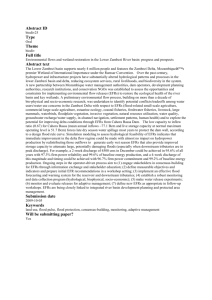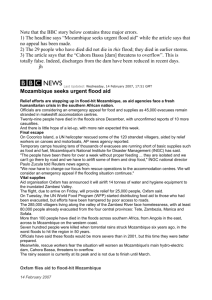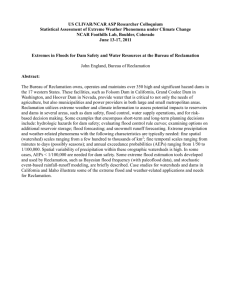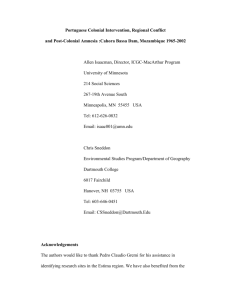Zambeze flood - linked to 106
advertisement
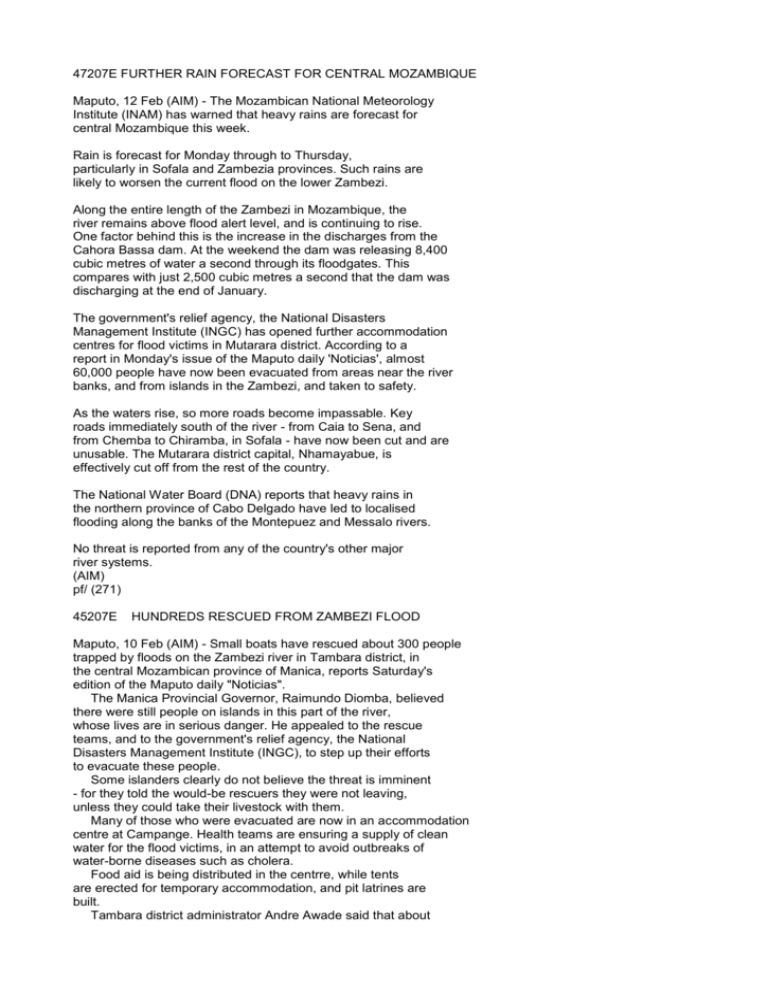
47207E FURTHER RAIN FORECAST FOR CENTRAL MOZAMBIQUE Maputo, 12 Feb (AIM) - The Mozambican National Meteorology Institute (INAM) has warned that heavy rains are forecast for central Mozambique this week. Rain is forecast for Monday through to Thursday, particularly in Sofala and Zambezia provinces. Such rains are likely to worsen the current flood on the lower Zambezi. Along the entire length of the Zambezi in Mozambique, the river remains above flood alert level, and is continuing to rise. One factor behind this is the increase in the discharges from the Cahora Bassa dam. At the weekend the dam was releasing 8,400 cubic metres of water a second through its floodgates. This compares with just 2,500 cubic metres a second that the dam was discharging at the end of January. The government's relief agency, the National Disasters Management Institute (INGC) has opened further accommodation centres for flood victims in Mutarara district. According to a report in Monday's issue of the Maputo daily 'Noticias', almost 60,000 people have now been evacuated from areas near the river banks, and from islands in the Zambezi, and taken to safety. As the waters rise, so more roads become impassable. Key roads immediately south of the river - from Caia to Sena, and from Chemba to Chiramba, in Sofala - have now been cut and are unusable. The Mutarara district capital, Nhamayabue, is effectively cut off from the rest of the country. The National Water Board (DNA) reports that heavy rains in the northern province of Cabo Delgado have led to localised flooding along the banks of the Montepuez and Messalo rivers. No threat is reported from any of the country's other major river systems. (AIM) pf/ (271) 45207E HUNDREDS RESCUED FROM ZAMBEZI FLOOD Maputo, 10 Feb (AIM) - Small boats have rescued about 300 people trapped by floods on the Zambezi river in Tambara district, in the central Mozambican province of Manica, reports Saturday's edition of the Maputo daily "Noticias". The Manica Provincial Governor, Raimundo Diomba, believed there were still people on islands in this part of the river, whose lives are in serious danger. He appealed to the rescue teams, and to the government's relief agency, the National Disasters Management Institute (INGC), to step up their efforts to evacuate these people. Some islanders clearly do not believe the threat is imminent - for they told the would-be rescuers they were not leaving, unless they could take their livestock with them. Many of those who were evacuated are now in an accommodation centre at Campange. Health teams are ensuring a supply of clean water for the flood victims, in an attempt to avoid outbreaks of water-borne diseases such as cholera. Food aid is being distributed in the centrre, while tents are erected for temporary accommodation, and pit latrines are built. Tambara district administrator Andre Awade said that about 2,000 people in the district had been directly affected by the flooding, and had lost 1,995 hectares of crops. Joao Ribeiro, deputy director of the INGC, said that a total of 1,728 flood victims were no taking shelter in 13 accommodation centres set up along the length of the Zambezi. Another 43,650 are in what are described as resettlement centres. Some of these people had to be forcibly evacuated from dangerous areas in Marromeu district. At Caia, in Sofala province, where the INGC has set up its operational headquarters, work on the new bridge over the Zambezi is at a standstill, and floodwaters completely surround the first pillar of the bridge. Nonetheless the flood has not interrupted the ferry service across the river from Caia to Chimuara - which is a vital link in the country's main north-south highway. However, the flood is now in danger of swamping the main ferry mooring ramp at Caia - in order to keep the service going, workers are clearing vegetation away from the access to a second, replacement ramp. But people who run informal bars and shops for users of the ferry have been advised to move. The Zambezi is bound to rise still higher, because, on Friday, the floodgates on the Cahora Bassa dam were opened still further. The dam management increased the discharges from Cahora Bassa from 6,770 to 8,400 cubic metres a second. Ribeiro told reporters that the situation in the Zambezi valley is still under control - but more boats have been sent to the areas with the largest number of people at risk. The number of helicopters available has risen from two to three. A large cargo helicopter may be used to rescue people from the rising waters. (AIM) pf/ (469) 30207E PRIME MINISTER OVERFLIES FLOOD AREA Maputo, 8 Feb (AIM) - Flooding in the Zambezi Valley is now "a matter of great concern", Mozambican Prime Minister Luisa Diogo told AIM on Thursday. Diogo overflew the Zambezi Valley on Wednesday to see for herself the extent of the damage. From the air, all that she could see of the islands in the river was the tops of a few houses poking above the waters. Fortunately, all the islanders themselves had left for the river banks, and there are no reports of any of them drowning. Initially, the islanders were refusing to leave, on the grounds that they were following traditional methods of risk assessment. These may work, since by the end of the day, according to Diogo, they had all left. There are no indications that the authorities had to use force against them. Diogo said there are still plenty of people in low-lying areas close to the river banks who have not yet heeded the authorities' warnings to seek higher ground. But she was optimistic that most of them would do so - for many of the peasant families in the valley keep two houses, one near their fields in the fertile areas close to the river, and one some distance away in the higher areas overlooking the valley. The Zambezi is certain to rise still higher, since there is another, still larger flood wave travelling down the river from the Cahora Bassa dam. On Wednesday, the dam operating company. HCB, increased the discharge from the floodgates from 5,170 to 6,770 cubic metres a second - though later in the day HCB cut the amount back to 6,100 cubic metres a second. On top of this wall of water from Cahora Bassa come the contributions from the Zambezi's swollen tributaries, the Luenha, the Revobue, and particularly the Shire. Diogo feared that, over the next few days, this would greatly affect the lower Zambezi valley, particularly the districts of Chinde, in Zambezia province, and of Marromeu in Sofala. There are now fears for the safety of the major investment in the area, the sugar plantation and mill of the Sena company (owned mainly by Mauritian concerns) in Marromeu. Work has already been undertaken to fill gaps in the Marromeu dikes: more than 1,000 sandbags have been used in the past few days to strengthen the dikes. Diogo pointed out that in the last major Zambezi floods, in 2001, the sugar company came close to disaster. Had the river risen then by a further 20 centimetres it would have come over the top of the dikes. She believed, however, that the Sena company had learned lessons from that experience. As in 2001, the government is preparing a major accommodation centre for flood victims at Chupanga, in Marromeu. Boats are now on hand to evacuate people who may be in danger in Luabo and Chinde, on the Zambezia side of the river, and take them across the Zambezi to Chupanga. At the moment, helicopters are only being used to overfly the valley and check on the progress of the flood. The use of aircraft to evacuate people is extremely expensive, and in the government's view is not currently needed. But that could change as the situation worsens. At the moment, a red alert has been declared along the entire length of the Zambezi within Mozambique. The stage above this, Diogo said, would be a declaration of a national disaster and at that point Mozambique would have little choice but to launch an appeal for international assistance. But the government has no intention of declaring an emergency while the situation is only one of alert, albeit maximum alert. The Prime Minister believed that HCB was handling the situation very well. It's priorities were to ensure the physical integrity of the dam, and to guarantee that the Cahora Bassa lake could continue to receive large amounts of water from further upstream. Diogo pointed out that in recent days between 8,000 and 10,000 cubic metres of water a second has entered the lake - but the flood gates have released much less than that (at most 6,770 cubic metres a second) into the river. She described HCB's cautious management as "serious and patriotic". Currently the lake is slightly less than 70 per cent full which means that the dam still has considerable room for manoeuvre should it continue to rain heavily upstream for the rest of February. Rescue operations are now under way in Tambara district, in Manica province. According to the district administrator, Andre Awade, cited in Thursday's issue of the Maputo daily "Noticias", people who ignored the authorities' appeals to move to safer areas are now stranded, and some of them are surviving by clinging onto trees. Four boats have been sent to the area to rescue them. (AIM) pf/ (790) WFP is exaggerating in order to raise money: 43207E WFP SOUNDS ALARM ABOUT ZAMBEZI FLOODING Maputo, 9 Feb (AIM) - The World Food Programme (WFP) on Friday expressed serious concern about the current flooding in the Zambezi Valley in central Mozambique. "We are particularly concerned about the worsening situation in Mozambique which has yet to hit peak levels and is still being fed by rains in neighbouring countries," said Amir Abdulla, WFP Regional Director for Southern Africa, cited in a WFP press release received by AIM.. "We have been using pre-positioned stocks to respond to the floods across the region but the severity of flooding in Mozambique will require urgent additional funding," he added. The priority destination for WFP aid has been the district of Mutarara in Tete province, scene of severe flooding on the Shire river, the major tributary of the Zambezi, at the end of January. The release said the WFP has been distributing 300 tonnes of pre-positioned emergency food rations to 2,000 people gathered in centres in Mutarara. But the release overstates the drama when it states that the rains have "filled the Cahora Bassa dam above capacity levels". In fact, as the bulletins from the National Water Board (DNA) clearly state, Cahora Bassa lake is about 70 per cent full. Hence the ability of the dam management to release through the floodgates much less water than the lake has been receiving. Were the lake really "above capacity", that would be extremely dangerous. Such a situation would endanger the physical integrity of the dam, and would force the management to open all the floodgates to the maximum extent. However, WFP is correct to warn that the current level of outflow from Cahora Bassa (6,770 cubic metres a second on Thursday) will push flooding in the Zambezi basin to levels not seen since the major flood of 2001. The WFP says that it will launch an appeal to the international community next week "to support the Mozambique government's efforts to contain the crisis". That appeal is likely to request food aid, air support to rescue people who are stranded and to deliver relief goods, and telecommunications equipment to facilitate coordination of the humanitarian response. The WFP estimate is that 285,000 people "may need food assistance for the next few months, as many have had to flee the rising flood waters, leaving behind their meagre possessions and food stocks". The release points out that WFP "already faces a critical shortfall in funding for all its operations in southern Africa, requiring 105 million US dollars through to the end of this year". "Our response in the region is hampered by a critical funding shortage and the need is now most acute in Mozambique," Abdulla said. "With the situation likely to worsen in the coming days, we are going to need the full support of the international community." (AIM) pf/ (464)
